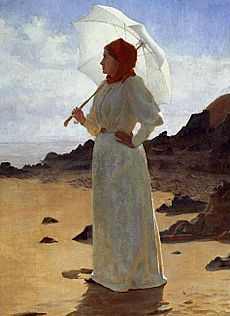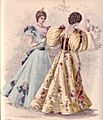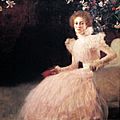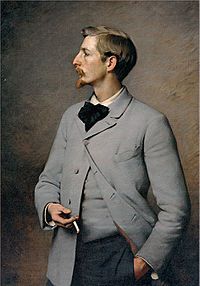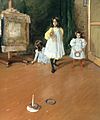1890s in Western fashion facts for kids
Fashion in the 1890s in Western countries was all about long, graceful lines, high collars, and the start of sportswear. It was a time of big changes in clothing, especially because of the invention of the drop-frame safety bicycle. This new bike made it easier for women to ride comfortably, which meant they needed different clothes!
Another big reason for changes in women's fashion, especially for those involved in the Aesthetic Movement in America, was the changing world around them. Women were becoming more active in their communities, in politics, and in society. Their clothes started to show this new freedom. As women of the Gilded Age got more chances to experience life outside the home, their fashion also became freer and allowed for more movement. This focus on being active led to clothes that let people move easily. Also, as ideas about gender roles changed, clothes became more about self-expression and showed a more natural shape of women's bodies.
The 1890s also saw the beginning of new ways to show fashion. While drawings were still common in fashion magazines, the first printed fashion photos appeared in the French magazine La Mode Pratique in 1892. These photos then became a regular weekly feature.
Contents
Women's Fashion in the 1890s
Fashionable women's clothes in the 1890s became less fancy than in earlier decades. Skirts were no longer huge like the crinolines of the 1850s, nor did they stick out at the back like the bustles of the late 1860s and mid-1880s. They also weren't as tight as in the late 1870s. However, corsets were still worn tightly, sometimes even more so.
In the early 1890s, dresses had a tight bodice (the top part) and a skirt that gathered at the waist. The skirt then fell more naturally over the hips than before. Big, puffy sleeves, called "leg-of-mutton" sleeves (or gigot sleeves), came back into style. They got bigger every year, reaching their largest size around 1895.
By the mid-1890s, skirts started to look like an A-line or a bell shape. In the late 1890s, sleeves became tighter again, often with small puffs or ruffles at the shoulder but fitted down to the wrist. Skirts took on a "trumpet" shape, fitting closely over the hips and flaring out just above the knee. Corsets in the 1890s helped create the "hourglass" figure, which was made famous by artist Charles Dana Gibson. Towards the very end of the 1890s, corsets became longer, giving women a slight S-bend shape that stayed popular into the Edwardian era.
Sportswear and Tailored Styles
New ideas about what women could do also made sportswear popular. Examples include special dresses for bicycling and tennis.
Simple, tailored clothes, inspired by men's styles, were worn for outdoor activities and travel. The shirtwaist, which was a bodice or blouse made like a man's shirt with a high collar, became popular for casual daytime wear. It was also the common outfit for women who worked. Walking suits had ankle-length skirts with matching jackets.
In 1891, people talked a lot about "rational dress" for women's health. This led to the creation of sports clothes. For example, hockey outfits included wide skirts and a belted blouse. Cycling became very popular, leading to "cycling costumes." These were shorter skirts or "bloomers," which were like Turkish trousers. By the 1890s, women cyclists increasingly wore bloomers in public, even with men. Bloomers seemed more common and fashionable in Paris than in England or the United States. In the U.S., bloomers were more for exercise than for fashion. The rise of women's college sports in the 1890s meant women needed clothes that allowed more freedom of movement than exercise skirts. By the end of the decade, most colleges with women had women's basketball teams, all wearing bloomers. These baggy bloomers paired with blouses became the first women's gym uniforms.
The "rainy daisy" was a style of walking or sports skirt that appeared in this decade. It was practical for wet weather because its shorter hemline didn't soak up puddles. These skirts were especially useful for cycling, walking, or sports because the shorter hems were less likely to get caught in bicycle parts or underfoot, allowing for freer movement.
Swimwear also developed, usually made of navy blue wool with a long tunic over full knickers (short, loose trousers).
Typical day dresses of the time had high necks, tight "wasp" waists, puffed sleeves, and bell-shaped skirts. Evening gowns had a square neckline, a wasp-waist cut, and skirts with long trains.
The Influence of Artistic Dress
In the 1890s, in both Europe and North America, "artistic" or "aesthetic" dress became more accepted as mainstream fashion. This style was influenced by the ideas of thinkers like John Ruskin and William Morris. A good example was the tea gown, a loose, uncorseted dress worn at home. In the United States, a magazine called Dress, the Jenness Miller Magazine reported that tea gowns were being worn outside the home for the first time at fancy summer resorts.
Before women had a bigger role outside the home, fashion was more traditional, modest, and restrained. However, in the 1870s and 80s, the Aesthetic Movement led to a change. Some women used fashion to challenge traditional home life and express their independence.
Hairstyles and Hats
At the start of the decade, hairstyles were similar to the 1880s, with curled or frizzy bangs over the forehead and hair swept to the top of the head. But after 1892, hairstyles were more and more influenced by the Gibson Girl look. By the mid-1890s, hair became looser and wavier, and bangs slowly went out of style. By the end of the decade, hair was often worn in a large bun on top of the head. This style was very popular in the early 1900s.
Shoes
High shoes with a large buckle on the front, which had been popular in the 1870s, came back in the 1890s. This popular shoe style had a few names like "Cromwell," "Colonial," and "Molière." At this time, materials like suede, leather, lace, and metal were used to make and decorate the shoes. Suede was new to the market in 1890 and was available in a few light colors.
Athletic Wear
The move towards practical fashion also affected women's athletic wear. Women in Paris started wearing bloomers for bicycling as early as 1893. In England, bicycle frames were designed lower so women could still ride in their dresses. Long, floor-length dresses slowly gave way to shorter hemlines and more casual athletic clothes. Similarly, bathing suits also became shorter and less covering. This was another sign of fashion changing towards more freedom and usefulness.
Women's Style Gallery 1890–1896
- Praskovia Tchaokovskaia wears a high-necked afternoon dress with puffed elbow-length sleeves and a fabric belt, Russia, 1890–92.
- A Bathing suit from 1890-1895, showing nautical fashion with navy color and a sailor collar and sleeves.
- Day dresses from 1892 have low waists and high necklines. Sleeves are gathered high at the shoulder and fitted to the lower arm. Skirts are fuller in the back.
- Gowns from 1892–93 feature short or elbow-length full, puffed sleeves and flower decorations.
- This City or traveling suit has full upper sleeves and a full back in the skirt.
- Walking suits from 1894 show shorter skirts and matching jackets with leg-of-mutton sleeves.
- Portrait photograph of Ernesto Tornquist and his family, around 1895.
- A Punch Cartoon from 1895 shows a fashionable bicycle suit.
- Natalie Barney in 1896.
- Charvet advertisement from 1896.
Women's Style Gallery 1897–1899
- Madame Faydou wears her hair in a knot on top of her head. Her black dress and her daughter's grey dress have fashionable leg-of-mutton sleeves, 1897.
- Catherine Vlasto wears a white dress with puffed elbow-length sleeves and ribbon bows. Her hair is parted in the center and casually puffed at her temples, 1897.
- This 1897 fashion plate shows an ideal fashionable figure. The jacket has an uneven closure and new, smaller sleeve puffs.
- Bathing costumes from 1898 have nautical details like sailor collars.
- A Dress of 1898 shows a short, wide puff at the shoulder over a long, tight sleeve.
- This Charvet corsage of 1898 is a blouse of pink cambric (a fine cotton fabric) with fine pleats and a white ruffled trim down the center.
- A Shirt-waist from Charvet in 1898 has groups of tucks down both sides of the front and back from the shoulders. It also has two deep horizontal tucks across the front. A wide pleat in the center is edged with a tiny black ruffle, which also goes around the bottom edge. The sleeves have diagonal tucks.
- Hats from a manufacturer's spring collection in 1898.
- A Gown (1898-1900) designed by Jacques Doucet, a famous French designer. It shows features of the aesthetic dress movement, being simple in design but fancy in materials.
- This 1899 fashion plate shows the narrow, gored skirt and more natural shoulder shape that would be popular in the early 1900s. It also shows the results of "S-bend" corseting.
- A Tea Gown from 1899 shows a "Watteau back" (a loose, flowing pleat from the shoulders) and frothy trim.
- Two women in Watteau-backed tea gowns with high sashed waists, 1899.
Cartoons About Fashion
Men's Fashion in the 1890s
The overall look for men in the 1890s was long, thin, and athletic. Hair was usually worn short, often with a pointed beard and a large mustache.
Coats, Jackets, and Trousers
By the 1890s, the sack coat (called a lounge coat in the UK) was quickly replacing the frock coat for most casual and semi-formal events. Three-piece suits, called "ditto suits," were popular. These included a sack coat with a matching waistcoat (or vest in the U.S.) and trousers. Sometimes, men wore a matching coat and waistcoat with trousers of a different color. Waistcoats of a contrasting color were also popular and could have collars and lapels or not. The usual style was single-breasted (meaning it had one row of buttons).
The blazer, a navy blue or brightly colored or striped flannel coat with patch pockets and brass buttons, was worn for sports, sailing, and other casual activities.
The Norfolk jacket stayed fashionable for hunting and rough outdoor activities. It was made of strong tweed or similar fabric and had two box pleats over the chest and back, with a fabric belt. When worn with matching breeches (or knickerbockers in the U.S.), it became the Norfolk suit. This suit was good for bicycling or golf with knee-length stockings and low shoes, or for hunting with sturdy boots or shoes with leather gaiters (coverings for the lower leg).
The cutaway morning coat was still worn for formal daytime events in Europe and big cities elsewhere.
The most formal evening wear was still a dark tail coat and trousers with a dark or light waistcoat. Evening wear was worn with a white bow tie and a shirt with a winged collar.
The less formal dinner jacket or tuxedo, which had a shawl collar (a rounded collar) with silk or satin trim, usually had only one button. Dinner jackets were suitable for formal dinners at home or at a men's club. The dinner jacket was worn with a white shirt and a dark tie.
Knee-length topcoats, often with collars made of contrasting velvet or fur, and calf-length overcoats were worn in winter.
Shirts and Neckties
Shirt collars were turned over or pressed into "wings," and they became taller throughout the decade. Dress shirts had stiff fronts, sometimes decorated with shirt studs, and buttoned up the back. Striped shirts were popular for casual occasions.
The usual necktie was a four-in-hand (a common knot) or an Ascot tie (a wide tie worn with a stickpin). But the 1890s also saw the return of the bow tie (in different sizes) for day wear.
Accessories
Just like earlier in the century, top hats were still required for upper-class formal wear. Bowlers and soft felt hats in various shapes were worn for more casual occasions. Flat straw boaters were worn for yachting and at the beach.
Men's Style Gallery
- Filipino Ilustrados Jose Rizal, Marcelo H. del Pilar, and Mariano Ponce in frock coats, 1890.
- The Painter John Singer Sargent in formal evening clothes, around 1890.
- Another portrait of Sargent, in day dress: dark coat and waistcoat, dark red ascot, and tall collar, around 1890. This picture shows the long, thin shape that was fashionable at this time.
- Oscar Wilde wears a frock coat with a pocket square, 1890s.
- Three men wearing three-piece suits and bowlers, 1893.
- Frederick Law Olmsted wears a tan topcoat over a gray suit, 1895.
- George du Maurier wears a double-breasted waistcoat with a shawl collar under his sack coat, with grey trousers. He wears square-toed shoes with spats (coverings for the top of the shoe), 1896.
- Country clothes: James Tissot wears breeches (short trousers) and high boots with a reddish collared waistcoat and a brown coat. Even with this casual outdoor outfit, he wears a tie, 1898.
- College fashion includes a straw boater hat. William Beveridge at Balliol, 1898.
Children's Fashion
Working Clothes
See also


